
This page last modified: 20 November 2015 (separate pages for all units now introduced to make page size manageable)

Note 1. Entries 154.14 and 154.15 are rather confused in the various manuscripts. Ingo Maier reports (personal communication) the primary readings shown below. Return
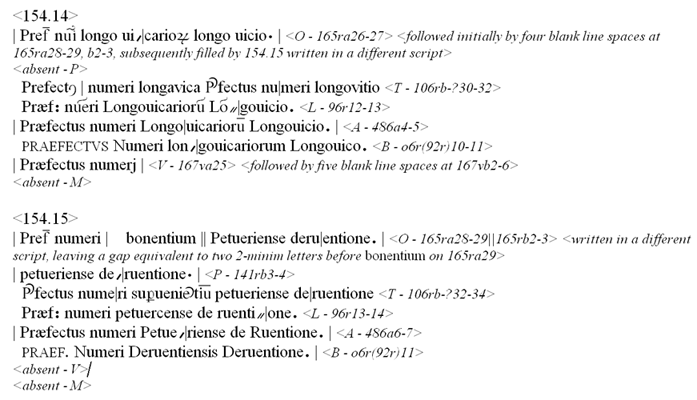
Transcription by Ingo Maier, and used with kind permission. O: Bodleian manuscript; P: Parisian manuscript; T: Trento manuscript; L: London (Victoria & Albert) manuscript; A: Alciatus (Basel 1546) printed edition; B: Froben printed edition; V: Vatican manuscript; M: Munich manuscript.It can be seen that in some of the manuscripts, portions of their entries are simply missing, albeit with spaces left for them to be filled in: clearly the entries in whichever manuscript from which they were being copied were hard to read. Seeck took the reading supervenientium (OC.XL.30) solely from the Trento manuscript, T (V in Seeck's apparatus), but this manuscript is at least one step further removed from the now-lost Speyer codex than is the Bodleian manuscript, O, which gives bonentium, so it is not clear why supervenientium should be a preferable reading, especially since the bonentium was added to O by a second scribe who had thus presumably taken care to check whichever manuscript was being copied at this point. See further discussion below for these two - or three - units.
Note 2. In 1976, M.W.C. Hassall suggested there was a lucuna in the list reading:
154.27 Tribunus cohortis secundae Dalmatarum Magniswhich has become widely accepted, as it resolves a number of problems with names along the Wall; this has implications for the Praepositus militum Tungrecanorum (132.3) under the Comes litoris Saxonici per Britanniam. See further discussion under entry 154.28.1. Return
154.28 Tribunis cohortis primae Aeliae Dacorum [Banna
154.28.1 Tribunus cohortis secundae Tungrorum C]amboglanna
154.29 Praefectus alae Petrianae Petrianis
Note 3. Seeck inserted (OC.XL.46) a "missing" unit at Luguvalli (i.e. Luguvalium, modern Carlisle) between items 154.29 and 154.30, even though there is no indication in any of the manuscripts that there should be a unit or even a place entry at this position. Many other notable places in the north of England that have garrisons attested in the centuries prior to the Notitia's compilation are similarly not mentioned in the Notitia, so why Seeck thought Carlisle was exceptional is something of a mystery. Return
Note 4. Regarding 154.37, the Cuneus Sarmatarum entry, the manuscripts omit the "S", reading armatarum; see here for further discussion. Return
All of the units listed above are limitanei units. However, some would also appear to duplicated as part of the command of the Comes Britanniarum. For instance the Comes is listed (102/5.251) as commanding a unit of Equites catafractarii iuniores, said to be drawn form the units under the command of the Magister Equitum, but no equites catafractarii units are actually listed in the Magister Equitum's list of units. It seems likely this unit is instead one and the same as that commanded by the Dux' Praefectus equitum catafractariorum (154.5), and that the Magister Equitum's list is not chronologically consistent with that of the Comes Britanniarum. Similarly the men of the Praefectus numeri Maurorum Aurelianorum (154.30) can be equated with the Comes' Equites scutarii Aureliaci (102/5.252).
Since field army units are less likely to have been used to shore up the border garrisons than the converse, it would appear that the British limitanei units were being reduced during the Notitia's working lifetime to reinforce the Gallic field army, which makes A.H.M. Jones' Comes Britanniarum thesis (a recent re-establishement not long before 420) seem rather untenable. See further discission in the Comes Britanniarum section.
Claudian, writing in 402 AD, says that Stilicho withdrew a 'legion' that was guarding aginst the Picts and Scots in Britain for use against the Goths. This may or may not have been a single unit, as opposed to a general military force comprised of several units, and it may or may not have been a legionary as opposed to say an auxiliary force (the word legion seems to have frequently been used in a non-technical way even by soldiers like Ammianus, to say nothing of poets like Claudian), and it may not have even been a reference to just a specific force, as opposed to an indication that Stilicho was summoning reinforcements even from the furtherest reaches of the empire, and yet it is tempting indeed to connect this 'legion' with the stationless Legio VI. However, I would posit the balance of the information does not support such a specific equation of Claudian with the Sixth from York. To me it appears that it, along with many other British limitanei units, was first drafted into a new and temporary command under a Comes Britanniarum before the entire command of the Comes was withdrawn from Britain in 402, along with various other units under the Dux Britanniarum and the Comes litoris Saxonici per Britanniam, and that while some indeed do seem to have served against the Goths in Illyricum and Italy, many others were posted elsewhere, especially Gaul.
The final form of the list of the Dux Britanniarum would thus appear to date from before that of the Comes Britanniarum. It however seemingly does not date right back to the original drawing up of the Notitia; otherwise we would expect to see a unit stationed at Segontium (see the discussion under the Comes Illyricum).
Below are shown the frontpieces from the Parisian manuscript, P; and the Froben printed edition, B:
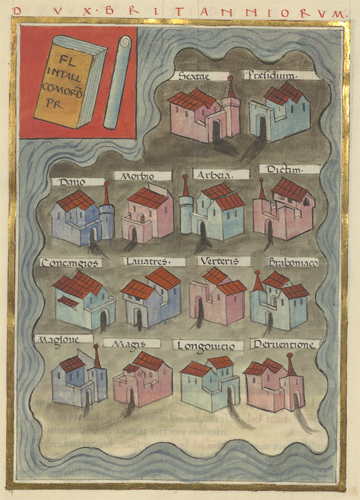
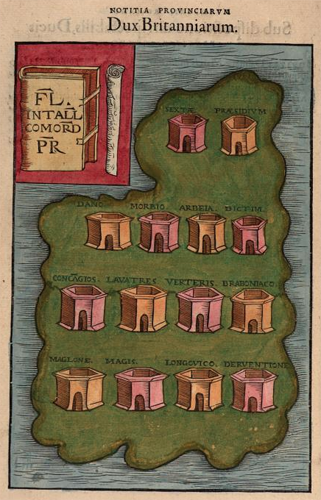
And below are the frontpiece from the first set of pictures in the Munich manuscript, M; and the corresponding illustration from the second set of pictures in the Munich manuscript, W:
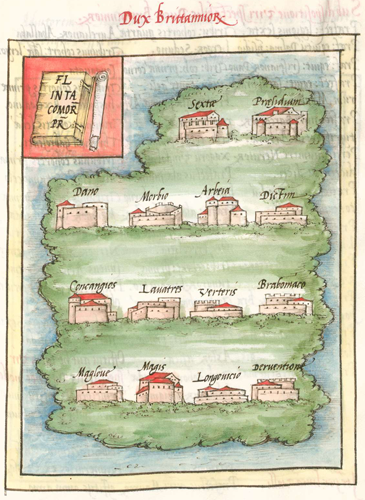

In contrast to the contemporary (i.e. 15th-century) Italianate appearance of the Bodleian and Parisian frontpieces, that from (W) is believed to be closer in style to the lost Codex Spirensis version, despite W's later (mid-16th century) date.
Below is a map showing the locations of the units under the Dux Britanniarum, with each map number ("X") corresponding to the appropriate Notitia entry: 154.X.
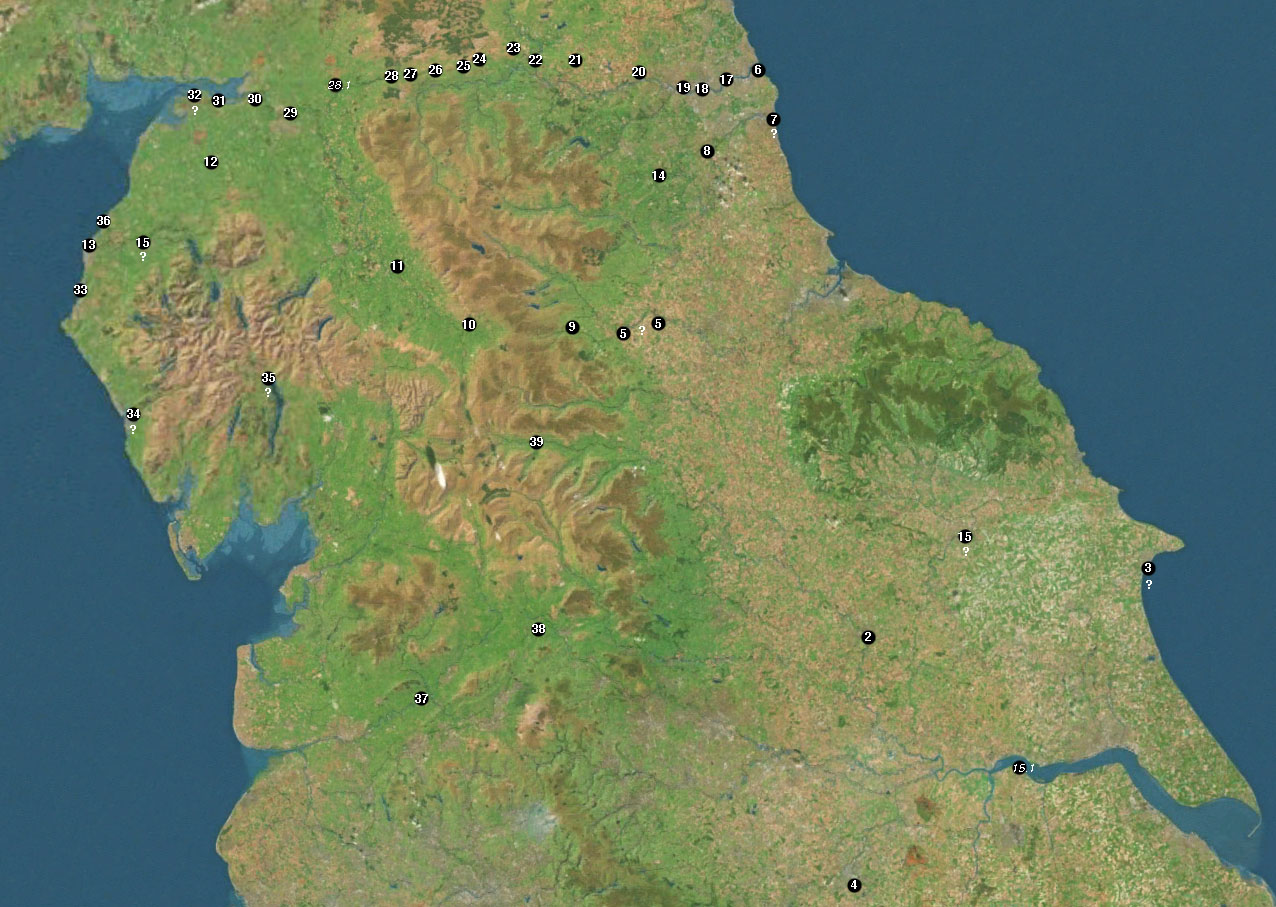
1. Ingo Maier; "Appendix 4: Numeration of the new edition of the compilation 'notitia dignitatum' (Cnd)"; last accessed 26 October 2015. See also for here for numbering examples. Return
2. M.W.C. Hassall; "Aspects of the Notitia Dignitatum", British Archaeological Reports, supplemental series 15 (1976), Oxford; at p 113. Return
3. Otto Seeck (Ed.); "Notitia Dignitatum accedunt Notitia urbis Constantinopolitanae et Latercula prouinciarum", Weidmann, Berlin, 1876; available here (last accessed 26 October 2015). Return
4. A.H.M. Jones; "The Later Roman Empire, 284-602; A Social, Economic, and Administrative Survey"; Blackwell, Oxford, 1964; vol. 3 of 3, at p 354. Return
5. Claudius Claudianus ("Claudian"); "De Bello Gothico", line 416. Return

Return to the Notitia index page.